#cephalopod fossil shell
Explore tagged Tumblr posts
Photo

Pleuroceras spinatum Ammonite Fossil, Lower Bajocian, Jurassic Spain | Authentic Specimen from Palencia + COA
Pleuroceras spinatum Ammonite Fossil – Lower Bajocian Stage, Middle Jurassic, Palencia, Spain
This beautifully preserved fossil is an authentic specimen of Pleuroceras spinatum, a fast-moving nektonic ammonite that lived during the Lower Bajocian stage of the Middle Jurassic, approximately 170 to 168 million years ago. Recovered from the marine deposits of Palencia, Spain, this ammonite features striking ribbing and a pronounced keel, making it highly desirable for collectors and educators alike.
Fossil Type & Species:
Type: Invertebrate Fossil (Ammonite Shell)
Species: Pleuroceras spinatum
Order: Ammonitida
Superfamily: Eoderoceratoidea
Family: Pleuroceratidae
Described by: Bruguière, 1789
Geological & Stratigraphic Details:
Location: Palencia Province, Castile and León, Spain
Formation: Bajocian marine limestone and marl beds
Geological Stage: Lower Bajocian (Middle Jurassic)
Age: ~170–168 million years ago
Biozone: Spinatum Biozone (named for this species)
Depositional Environment: Shallow marine shelf with carbonate-rich sedimentation ideal for fossil preservation
Morphology & Features: This Pleuroceras spinatum ammonite shows:
Planispiral coiling with a flat to moderately convex venter
Sharp, radiating ribs that project outward and curve slightly forward
Prominent keel (carina) running along the outer margin of the shell
Compressed, discoidal shell form with well-defined ornamentation
Colour typically preserved in earthy tones, with subtle contrast between fossil and matrix
Notable: Pleuroceras spinatum is one of the most characteristic ammonites of the Lower Bajocian and is used as a key biostratigraphic marker across Europe. Its distinctive morphology, coupled with its broad palaeogeographic distribution, makes it a cornerstone fossil in Jurassic ammonite studies.
Specimen Details:
Origin: Palencia, Spain
Species: Pleuroceras spinatum
Fossil Type: Ammonite Shell (Invertebrate)
Geological Stage: Lower Bajocian, Middle Jurassic
Size Reference: Scale rule square = 1cm (see photo for full dimensions)
Note: The exact specimen shown in the listing photo is the one you will receive
Authenticity & Quality: All of our fossils are 100% genuine and carefully selected. This item comes with a Certificate of Authenticity and has not been reconstructed or artificially enhanced.
Why Choose This Fossil? A valuable acquisition for:
Fossil ammonite collectors
Academic study and teaching
Jurassic marine palaeontology collections
Unique and natural display pieces
Shipping & Packaging: We ship worldwide using eco-conscious packaging and tracked delivery. Each specimen is carefully packed to ensure safe and secure transit.
Own a classic ammonite from the Jurassic seas of Spain with this rare and detailed Pleuroceras spinatum fossil.
All of our Fossils are 100% Genuine Specimens & come with a Certificate of Authenticity.
#Pleuroceras spinatum ammonite#Lower Bajocian ammonite Spain#Jurassic ammonite fossil#Palencia fossil ammonite#authentic Spanish ammonite#fossil with COA#collector ammonite shell#real ammonite fossil#Pleuroceras ammonite Jurassic#ammonite Spain for sale#fossil sea creature#Bajocian marine fossil#cephalopod fossil shell
0 notes
Text
Round 3 - Cephalopoda - Myopsida




(Sources - 1, 2, 3, 4)
Order: Myopsida
Common Name: “Myopsid Squids” or “Coastal Squids”
Families: 2 - Australiteuthidae and Loliginidae (“pencil squids”)
Anatomy: well-developed internal shell; eight short arms and two longer, clubbed tentacles ornamented with simple suckers; lack a secondary eyelid, instead covered by a transparent corneal membrane; communicate using a variety of color, shape, and texture changes
Diet: crustaceans, small fish, other mollusks
Habitat/Range: coastal waters worldwide, generally feeding on or near the ocean floor
Evolved: around the Eocene

Propaganda under the cut:
A Loligo fossil known from the Oligocene of Russia, is the earliest true squid known from a complete body fossil.
The Atlantic Brief Squid (Lolliguncula brevis) is the only cephalopod known to tolerate brackish water, venturing into the Chesapeake Bay.
Some cephalopods are able to fly through the air for distances of up to 50 metres (160 ft)! They can achieve these ranges by jet-propulsion, squirting water from their funnel even while in the air. The Caribbean Reef Squid (Sepioteuthis sepioidea) (image 1) has been observed spreading its tentacles out in a circle to guide its flight. This behavior is presumably for avoiding predators and/or for saving energy during migrations.
Most cephalopods are colorblind, even though they use colors, patterns, and flashing to communicate with each other. They do this through nervous control of their chromatophores, as well as cells such as iridophores and leucophores reflecting light from the environment. Caribbean Reef Squids can even send one message via color patterns to a squid on their right, while they send another message to a squid on their left, splitting their color pattern lengthwise down their body. They may do this by sensing light levels directly through their skin, rather than their eyes, utilizing photosensitive molecules called opsins. They may also be able to utilize chromatic aberration through their oddly shaped pupils.
#fun fact if you look up ‘reef squid’ in the Tumblr gif library you get mostly squids#but if you look up ‘Caribbean reef squid’ you get what I assume are aaaaall squid game gifs???#animal polls#Round 3#Cephalopoda#Myopsida
311 notes
·
View notes
Text

The distinctive pinhole eyes, leathery hood, and numerous tentacles of modern nautiluses were traditionally thought to represent the "primitive" ancestral state of early shelled cephalopods – but genetic studies have found that that nautiluses actually secondarily lost the genes for building lensed eyes, and their embryological development shows the initial formation of ten arm buds (similar to those of coeloids) with their hood appearing to be created via fusing some of the many tentacles that form later.
There's a Cretaceous nautilidan fossil that preserves soft tissue impressions of what appear to be pinhole eyes and possibly a remnant of a hood, so we know these modern-style nautilus features were well-established by the late Mesozoic. But for much more ancient Paleozoic members of the lineage… we can potentially get more speculative.
So, here's an example reconstructed with un-nautilus-like soft parts.
Solenochilus springeri was a nautilidan that lived during the Late Carboniferous, around 320 million years ago, in shallow tropical marine waters covering what is now Arkansas, USA.
Up to about 20cm in diameter, (~8"), its shell featured long sideways spines which may have served as a defense against predators – or possibly as a display feature since they only developed upon reaching maturity.
———
NixIllustration.com | Tumblr | Patreon
References:
Anthony, Franz. "500 million years of cephalopod fossils" Earth Archives, 19 Feb. 2018, https://eartharchives.org/articles/500-million-years-of-cephalopod-fossils/index.html
Klug, Christian, et al. "Preservation of nautilid soft parts inside and outside the conch interpreted as central nervous system, eyes, and renal concrements from the Lebanese Cenomanian." Swiss Journal of Palaeontology 140 (2021): 1-11. https://doi.org/10.1186/s13358-021-00229-9
Korn, Dieter, and Christian Klug. "Early Carboniferous coiled nautiloids from the Anti-Atlas (Morocco)." European Journal of Taxonomy 885 (2023): 156-194. https://doi.org/10.5852/ejt.2023.885.2199
Kröger, Björn, Jakob Vinther, and Dirk Fuchs. "Cephalopod origin and evolution: a congruent picture emerging from fossils, development and molecules: extant cephalopods are younger than previously realised and were under major selection to become agile, shell‐less predators." BioEssays 33.8 (2011): 602-613. https://doi.org/10.1002/bies.201100001
Mikesh, David L., and Brian F. Glenister. "Solenochilus Springeri (White & St. John, 1868) from the Pennsylvanian of Southern Iowa." Proceedings of the Iowa Academy of Science. Vol. 73. No. 1. 1966. https://scholarworks.uni.edu/pias/vol73/iss1/39/
Shchedukhin, A. Yu. "New Species of the Genus Acanthonautilus (Solenochilidae, Nautilida) from the Early Permian Shakhtau Reef (Cis-Urals)." Paleontological Journal 58.5 (2024): 506-515. https://www.researchgate.net/publication/384922837_New_Species_of_the_Genus_Acanthonautilus_Solenochilidae_Nautilida_from_the_Early_Permian_Shakhtau_Reef_Cis-Urals
Wikipedia contributors. “Nautilida” Wikipedia, 26 Nov. 2024, https://en.wikipedia.org/wiki/Nautilida
Wikipedia contributors. “Solenochilus” Wikipedia, 28 Apr. 2022, https://en.wikipedia.org/wiki/Solenochilus
#science illustration#paleontology#paleoart#palaeoblr#solenochilus#solenochilidae#nautilida#nautiloid#cephalopod#mollusc#invertebrate#art#doing the inverse of all those ammonite reconstructions that make them look like nautiluses
220 notes
·
View notes
Text

This floating alien egg is Octameroceras, they're part of a group of cephalopods called Oncocerids which diverged earlier than the nautiloids and ammonites.
As they reach maturity, their shell opening, the aperture closes in on their face creating these Giger-esque shapes, and we can only speculate what bizarre mangled forms the creature peeping through that opening would have.
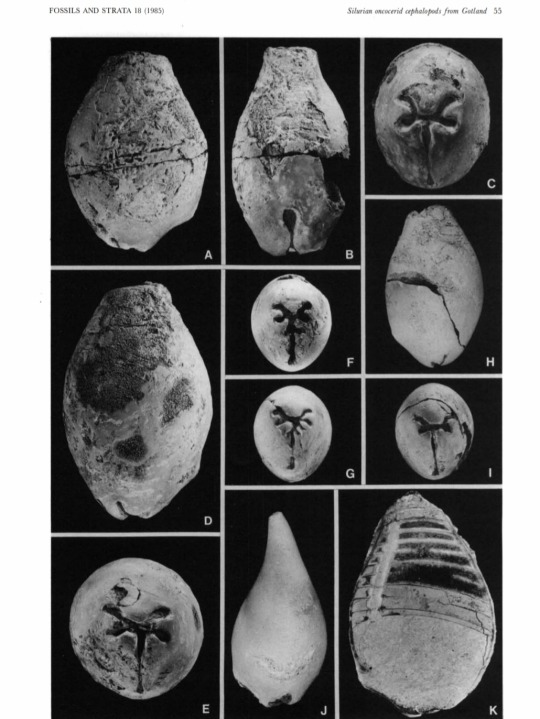
[image credit: Stridsberg, S. 1 985 05 09: Silurian oncocerid cephalopods from Gotland. Fossils and Strata, N o. 1 8, pp. 1-65. Oslo ISSN 0300- 9491. ISBN 82- 00- 07575-3.]
#art#paleoart#paleo art#palaeoblr#paleontology#cephalopod#Oncocerid#Oncocerida#octameroceras#Palaeozoic#blender3d#blender#3d model#animation 3d#animation#sea creatures
2K notes
·
View notes
Text
i was so hung up on the text misidentifying plesiosaurs and ichthyosaurs as "dinosaurs" that i completely missed how they called ammonites and belemnites "stones".

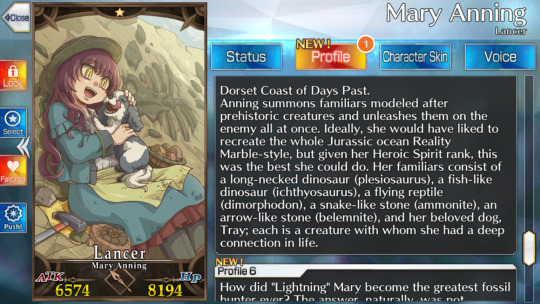
come on man, how do you correctly identify the pterosaur as a flying reptile distinct from dinosaurs, but in the same sentence call plesiosaurus and ichthyosaurus 'dinosaurs'
#I MEAN I GUESS THEY'RE STONES NOW#but if you're gonna be that technical so's everything else she summons asdgfhdjdshadshf#for the record ammonites and belemnites *were* cephalopods - close relatives to octopus and squid#but ammonites are famous for having an external shell (which could get really really weird in some species)#and both groups of animals are very very commonly found as fossils#hakunonon vs the gacha
9 notes
·
View notes
Text
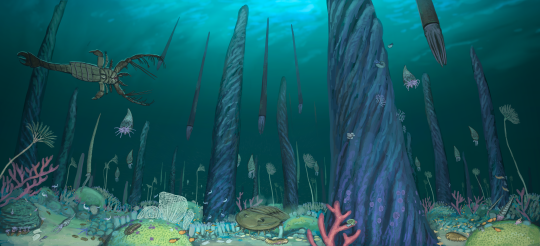
Here the result of the last formation stream of 2024. Over the course of 6 hours we explored the many organisms that inhabited the reefs of the Whitewater formation.
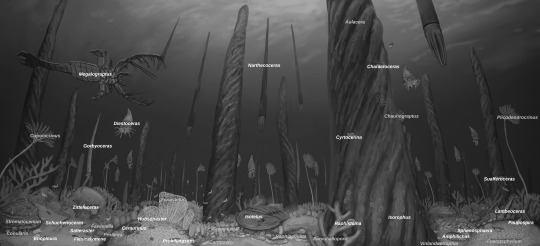
This formation preserves a rich benthic community with many sessile animals. Towering above all were the giant columnar sponges of the genus Aulacers, up to 3 m tall Ordovician skyscrapers. Between them hovered cephalopods and swam the eurypterid Megalopraptus.

Most organisms from here wer small, just a few centimeters, which is why Discord member JW made a second size chart just to bring across how the largest animals, Megalograptus and the giant trilobite Isotelus, compared to the rest.
I think something that is often overlooked in discussions about these formations is the animals we don't have. There are no crustaceans here, no jellyfish, although they probably still made up a significant part of the biomass. These animals are simply not preserved which makes our image of the Whitewater formation incomplete and biased towards the hard shelled organism. As a paleoartist one is constantly reminded of such gaps, we have to decide how much we want to speculate or borrow from other localities, or if we want to stick strictly to the fossil record.
In these formation pieces I usually do the latter but I'm painfully aware how much I miss in each piece.
Btw. since this is the last formation piece of the year I would love to hear which one was your favorite?!
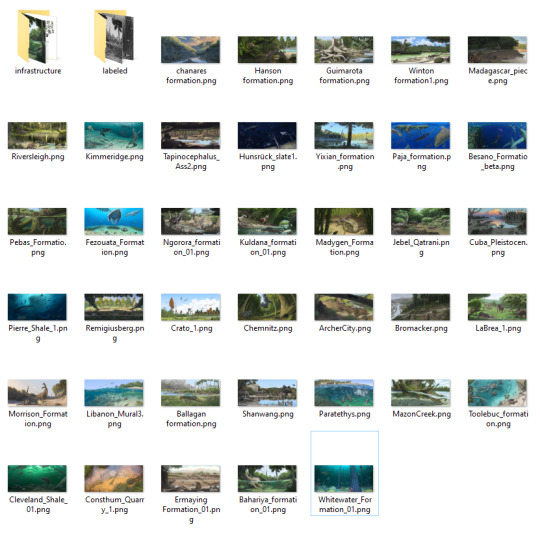
252 notes
·
View notes
Text
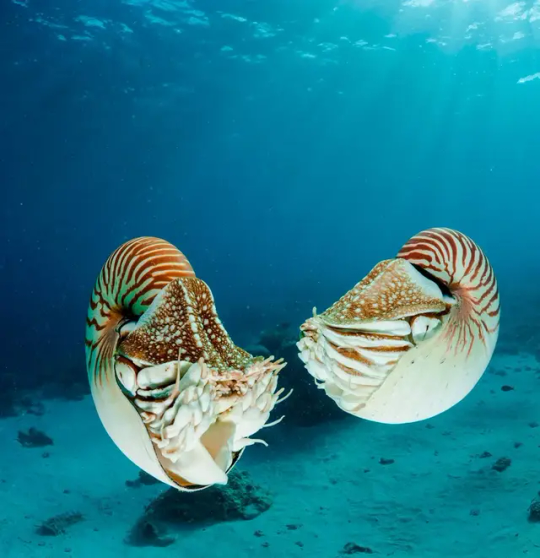

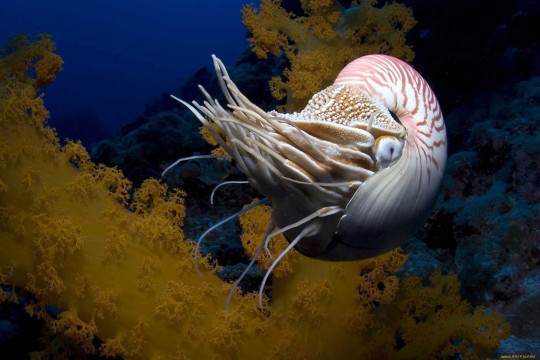
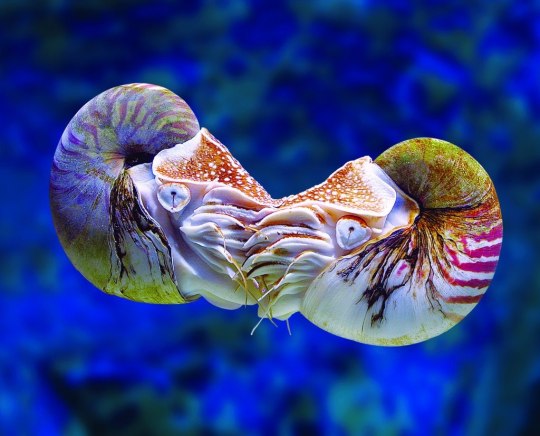
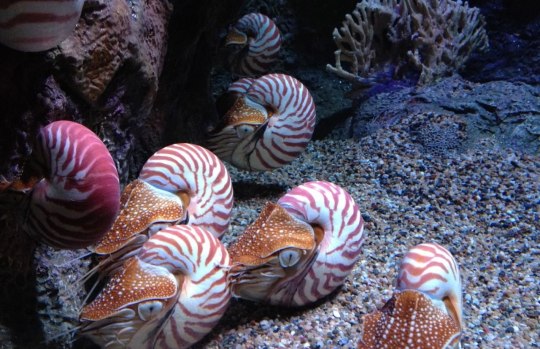
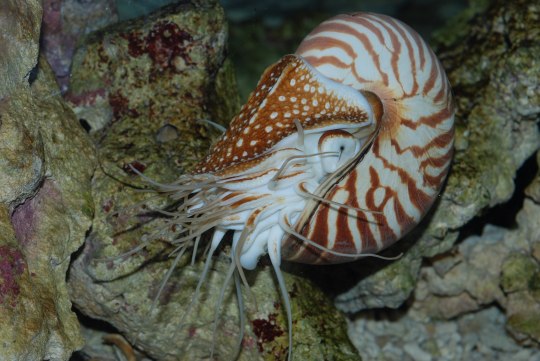
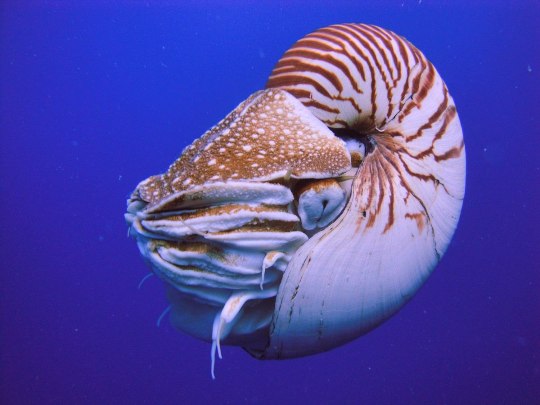
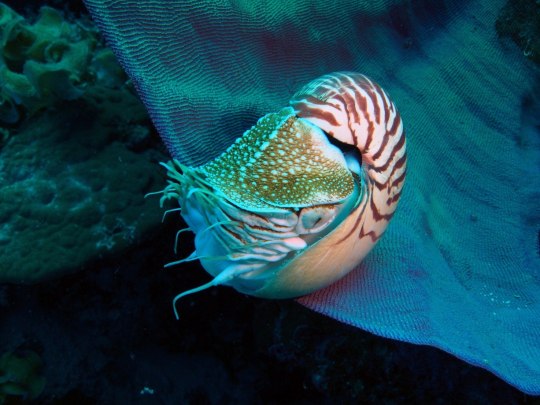




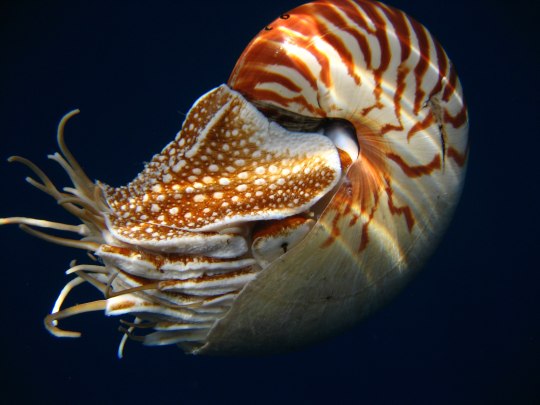
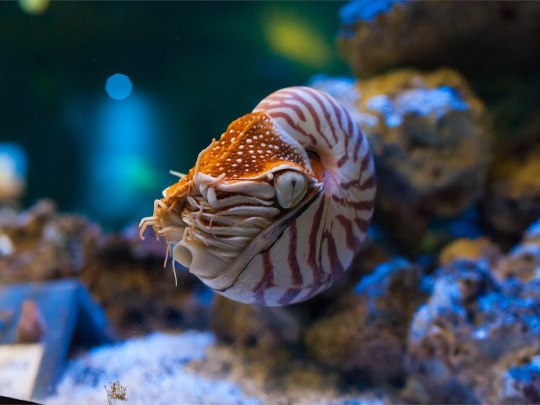
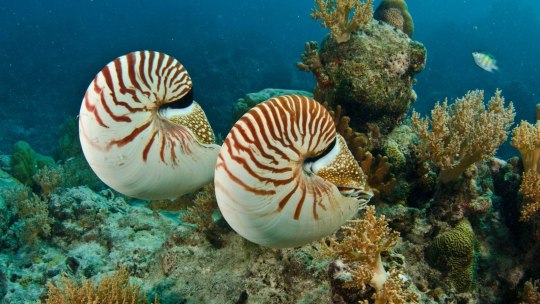
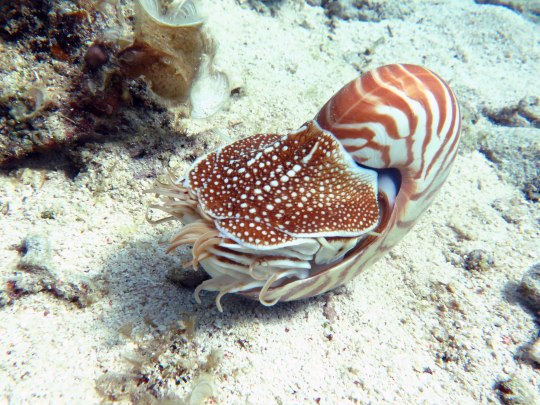
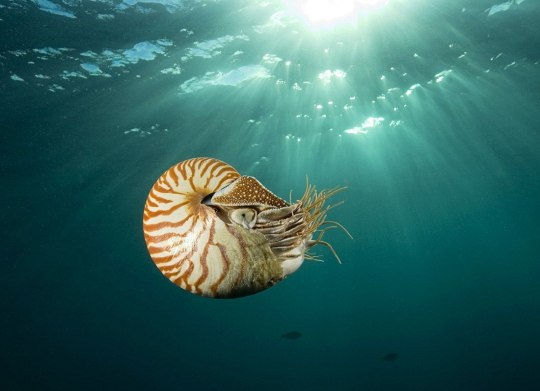

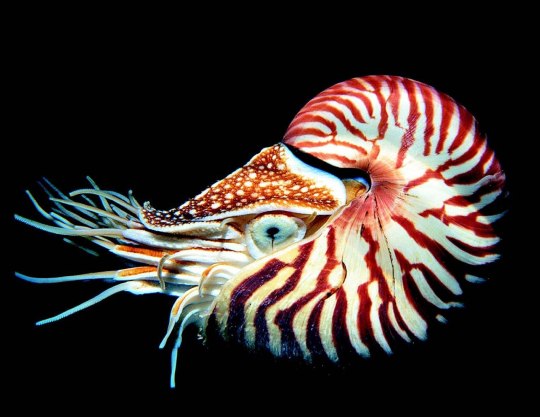

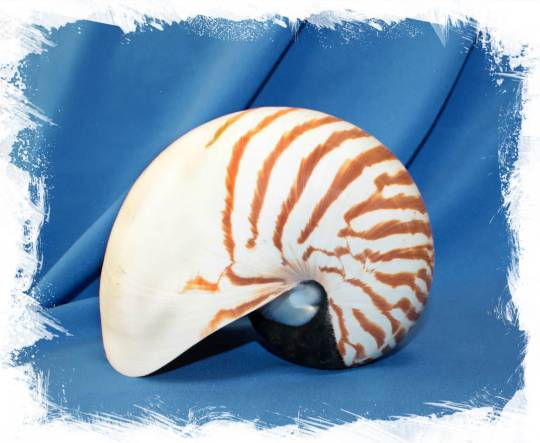
Наутилус (лат. Nautilus) — род головоногих моллюсков, которых относят к «живым ископаемым». Самый распространенный вид — Nautilus pompilius. Наутилусы относятся к единственному современному роду подкласса наутилоидей. Первые представители наутилоидей появились в кембрии, а его развитие пришлось на палеозой. Наутилиды почти вымерли на границе триаса и юры, но все же дожили до наших дней, в отличие от своих родственников аммонитов. Некоторые виды древних наутилусов достигали размера в 3,5 м. Представители самого крупного вида современных наутилусов достигают максимального размера в 25 см.
Спиральный «домик» моллюска состоит из 38 камер и «построен» по сложному математическому принципу (закон логарифмической прогрессии). Все камеры, кроме последней и самой большой, где размещается тело наутилуса с девятью десятками «ног», соединяются через отверстия между собой сифоном. Раковина наутилуса двухслойная: верхний (наружный) слой – фарфоровидный – действительно напоминает хрупкий фарфор, а внутренний, с перламутровым блеском – перламутровый. «Домик» наутилуса растет вместе с хозяином, который перемещается по мере роста раковины в камеру попросторней. Пустое жилище моллюска после его гибели можно встрети��ь далеко от его места обитания – после гибели «хозяина» их раковины остаются на плаву и перемещаются по воле волн, ветров и течений.
Интересно, что двигается наутилус «в слепую», задом наперед, не видя и не представляя препятствий, которые могут оказаться на его пути.И еще одно удивительное качество этих древних обитателей Земли – у них потрясающая регенерация: буквально через несколько часов раны на их телах затягиваются, а в случае потери щупальца быстро отрастает новое.
Nautilus is a genus of cephalopods, which are classified as "living fossils". The most common species is Nautilus pompilius. Nautilus belong to the only modern genus of the Nautiloid subclass. The first representatives of the Nautiloids appeared in the Cambrian, and its development took place during the Paleozoic. The Nautilids almost died out on the border of the Triassic and Jurassic, but still survived to the present day, unlike their Ammonite relatives. Some species of ancient Nautilus reached a size of 3.5 m. Representatives of the largest species of modern nautilus reach a maximum size of 25 cm.
The spiral "house" of the mollusk consists of 38 chambers and is "built" according to a complex mathematical principle (the law of logarithmic progression). All chambers, except the last and largest, where the nautilus body with nine dozen "legs" is located, are connected through holes with a siphon. The nautilus shell is two–layered: the upper (outer) layer – porcelain–like - really resembles fragile porcelain, and the inner, with a mother-of-pearl luster - mother-of-pearl. The nautilus's "house" grows with its owner, who moves as the shell grows into a larger chamber. The empty dwelling of a mollusk after its death can be found far from its habitat – after the death of the "owner", their shells remain afloat and move at the will of waves, winds and currents.
Interestingly, the Nautilus moves "blindly", backwards, without seeing or imagining the obstacles that may be in its path.And another amazing quality of these ancient inhabitants of the Earth is that they have amazing regeneration: in just a few hours, the wounds on their bodies heal, and in case of loss of tentacles, a new one grows quickly.
Источник:://t.me/+t0G9OYaBjn9kNTBi, /sevaquarium.ru/nautilus/, /habr.com/ru/articles/369547/, //wallpapers.com/nautilus, poknok.art/6613-nautilus-molljusk.html, //wildfauna.ru/nautilus-pompilius, /www.artfile.ru/i.php?i=536090.
#fauna#video#animal video#marine life#marine biology#nature#aquatic animals#cephalopods#Nautilus#nautilus pompilius#living fossils#ocean#benthic#coral#plankton#beautiful#animal photography#nature aesthetic#видео#фауна#природнаякрасота#природа#океан#бентосные#головоногие моллюски#Наутилус#живое ископаемое#коралл#планктон
187 notes
·
View notes
Text
If you asked me as a kid what my favorite animal was, there's a good chance I'd respond "chambered nautilus", though I probably would mispronounce it. I don't know if it's still my favorite but it's definitely up there in the pantheon of weird critters. For this Wet Beast Wednesday, I'll discuss my childhood favorite.
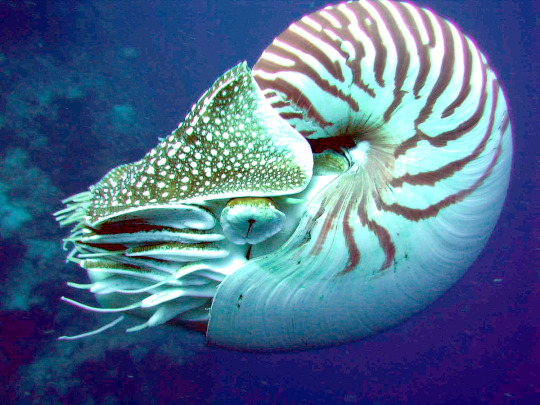
(image: a nautilus)
The nautilus is a cephalopod that lives in a curved shell and looks similar to (but is not closely related to) the extinct ammonites. There are 6 living species in two genera, but 90% of the time when someone is discussing nautiluses they are referring to the most well-known species: Nautilus pompilius or the chambered nautilus. Nautiloids are ancient, going back to at least the late triassic with their more primitive ancestors going back as far as the ordovician period, a time when only invertebrates and primitive plants occupied the land and true fish had not yet appeared. Because of their ancient history, nautiluses are sometimes considered living fossils. I have ranted before on how misleading the term "living fossil" is so I'll spare you that for now. Nautiloids are considered a sister group to the celoids, which contains all the squid, octopus, cuttlefish, and everything else we thinks of as cephalopods. Nautiluses should not be confused with paper nautiluses. Also called argonauts, paper nautiluses are a group of octopi that make an egg case which looks like a shell.
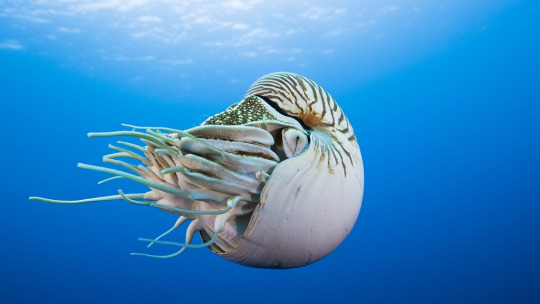
(image: a nautilus)
The most noticeable feature of a nautilus is its shell. The shell is smooth and finely curving, naturally growing in the shape of a logarithmic spiral (though not, as is commonly stated, a golden ratio spiral). The shell has a stripy outer layer and an inner layer coated with nacre. Internally, the shell is divided into camarae (chambers) separated from each other by walls called septa. Each septum has a small hole in it through which a strand of tissue called the siphuncle passes. Most of the nautilus's body is in the foremost and largest chamber. The shell grows new septa as the animal grows, with the nautilus's body moving to a new chamber as it becomes too large for previous ones. Juveniles are typically born with 4 septa, with adults having as many as 30. In addition to providing protection from predators, the shell is also key for regulating buoyancy. The septa can contain pressurized gas or water and the siphuncle regulates their contents by either adding or removing water to increase or decrease buoyancy. Because of its pressurized contents, the shell can only withstand pressure at depths up to 800 M (2,400 ft) before imploding. Oddly enough, nautiluses can be safely brought up from deep waters where most animals would be killed by the pressure changes. To move, the nautilus pulls water into the first chamber of the shell using its hyponome (siphon) and shoots it back out. The chambered nautilus is the largest species, with a maximum shell diameter of 25 cm (10 in), though most get no larger than 20 cm (8 in).
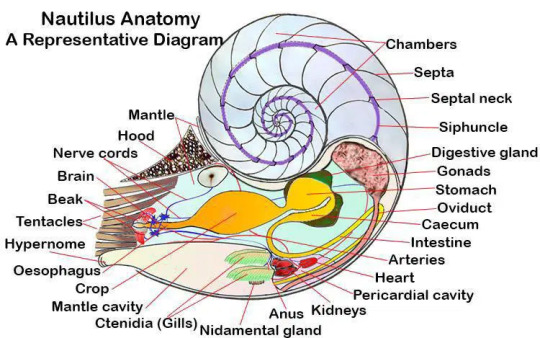
(image: a diagram of nautilus anatomy. source)
Where celoid cephalopods have tentacles, nautiluses instead have numerous cirri. Unlike tentacles, cirri are less muscular, are not elastic, and have no suckers. They are used to grab objects using their ridged surfaces and can hold in so hard that trying to take an object away from a nautilus can rip off its cirri, which will remain firmly attached. In addition, the nautilus has modified cirri that serve as olfactory receptors and a pair that serve to open and close the shell when the nautilus needs to retract into it or emerge. Nestled within the cirri is the beak, which is used to consume the nautilus's primary prey of invertebrates, though they have also been seen scavenging fish. Their eyes are less developed than most cephalopods, lacking a lens and consisting of a small pinhole that only allows the nautilus to see simple imagery. Their brains are differently structured than most cephalopods and studies have found them to have considerably shorter long-term memories.
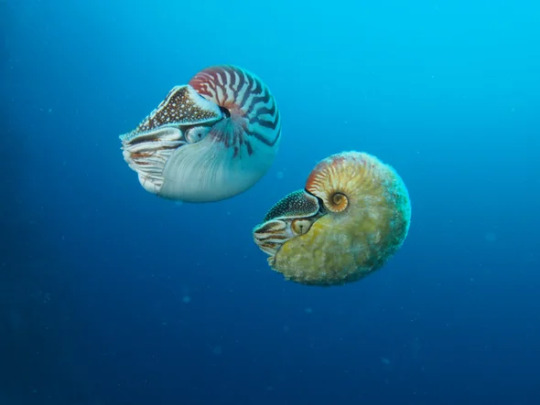
(image: a chambered nautilus (upper left) next to a rare Allonautilus scrobiculatus. source)
Cephalopod reproduction is quite different than that of other cephalopods. While most cephalopods are short-lived and semelparous (reproducing only once), nautiluses can live over 20 years and reproduce multiple times (iteroparity). They do not reach sexual maturity until around 15 years old, with females laying eggs once per year. Eggs are attached to rocks and take 8 to 12 months to hatch. Males have a structure called the spadix composed of 4 fused cirri that they use to transfer sperm to females. Females lose their gonads after laying their eggs and will regenerate them for the next year's mating season. Interestingly, male nautiluses seem to vastly outnumber the females. EDIT: @bri-the-nautilus in the replies found an alternate explanation for the disparity in male and female numbers you should check out. TLDR; the females are asocial.
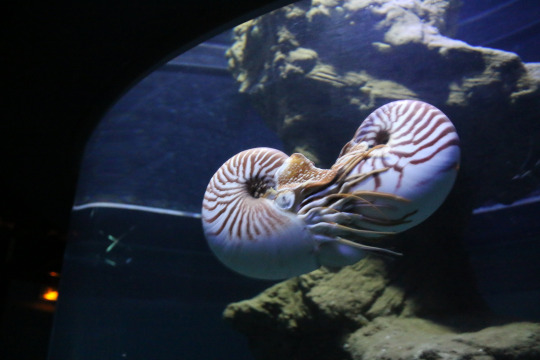
(image: nautiluses mating)
Nautiluses are found in the Indo-Pacific reagion of the ocean and can be found on the steep slopes of coral reefs. They prefer to inhabit waters several hundred meters down. It was once believed that they would rise to shallow waters at night to feed, lay eggs, and mate, but their vertical migration behavior has since been shown to be more complex than that. They have noon been fished by humans for their shells, which have become popular subjects in art and can be made into a number of decorative pieces. The nacre of the shell can be polished into osmeña pearl, which can be quite valuable. Demand for the shells combined with the late sexual maturity and low fecundity is threatening all the species. As of 2016, nautiluses have been added to the CITES Appendix II, making them protected by limiting international trade of their shells. Despite this, they are still threatened and require further protection

(image: a carved and painted nautilus shell from the Poldi Pezzoli Museum, Milan)
#wet beast wednesday#nautilus#chambered nautilus#cephalopod#marine biology#zoology#biology#ecology#animal facts
1K notes
·
View notes
Note
noooo
BEHOLD

fossils :>
Eats them
7 notes
·
View notes
Photo

Liparoceras cheltiense Ammonite Fossil - Lower Pliensbachian, Jurassic, Blockley, Gloucestershire, UK | 100% Genuine Specimen + COA
A stunning and rare Liparoceras cheltiense Ammonite Fossil from the Lower Pliensbachian Stage, Jurassic, Blockley, Gloucestershire, UK. This beautifully preserved ammonite showcases the intricate ribbing and robust shell structure characteristic of this species, making it a valuable piece for collectors, educators, and fossil enthusiasts alike.
✅ 100% Genuine Specimen – Every fossil we sell is authentic and comes with a Certificate of Authenticity.
✅ From the Alice Purnell Collection – A carefully curated specimen with historical significance.
✅ What you see is what you get – The listing photos show the exact specimen you will receive.
✅ Includes size reference – Scale cube in photos = 1cm. Please refer to the images for full dimensions.
✅ Ideal for collectors, display, or scientific study – A visually stunning and scientifically significant ammonite specimen.
About Liparoceras cheltiense Fossil Ammonites:
Liparoceras cheltiense is a species of ammonite from the Lower Pliensbachian Stage of the Early Jurassic period, approximately 190-195 million years ago. These ammonites belonged to an extinct group of marine cephalopods related to modern-day squids, octopuses, and nautiluses.
This species is known for its thick, evolute shell with strong ribbing and pronounced keels, making it a distinctive and highly recognizable ammonite. Fossils of Liparoceras are found in marine sedimentary deposits, particularly in Blockley, Gloucestershire, UK, a site well-known for its exceptional fossil preservation.
Ammonites like Liparoceras cheltiense played a crucial role in prehistoric marine ecosystems and are important index fossils used by paleontologists to date rock layers. Their intricate shell patterns and evolutionary significance make them highly sought-after by collectors and researchers.
Perfect for display, educational purposes, or as a unique gift for fossil lovers and paleontology enthusiasts, this ammonite is a one-of-a-kind addition to any fossil collection.
Shipping & Packaging:
🔹 Securely packed for safe transit 🔹 Worldwide shipping available 🔹 Tracked & insured delivery options
Why Buy from Us?
🔹 Trusted Seller – Specializing in fossils, minerals, and natural history specimens. 🔹 Certified Authenticity – Every purchase includes a signed Certificate of Authenticity. 🔹 Ethically Sourced – All our fossils are legally and responsibly collected.
Own a scientifically valuable piece of Jurassic history today!
#Liparoceras cheltiense#fossil ammonite#Jurassic ammonite#Blockley ammonite#Gloucestershire fossil#UK fossil#Lower Pliensbachian fossil#ammonite collector#ammonite specimen#ammonite shell#ammonite fossil for sale#rare ammonite#prehistoric fossil#fossilized ammonite#geological specimen#fossil display#ammonite identification#ammonite paleontology#fossil hunting#ammonite evolution#Alice Purnell Collection#cephalopod fossil#fossil enthusiast#ammonite shop#ammonite decor#ammonite history#fossil gift#ammonite energy
2 notes
·
View notes
Text
Taxonomy Tournament: Cephalopods
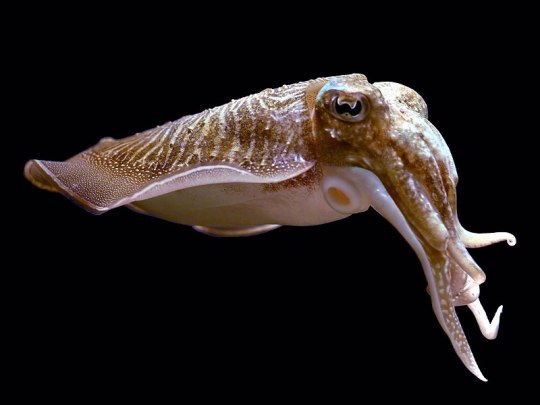
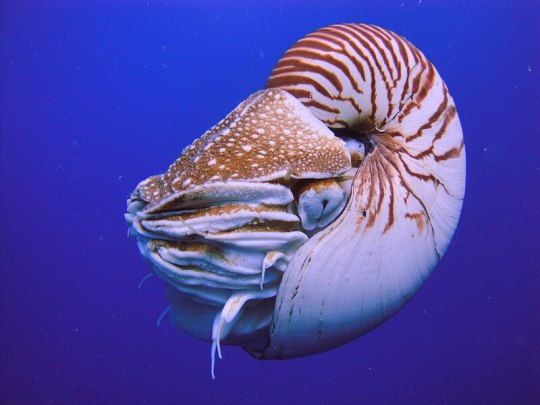
Sepiida. This order is made up of cuttlefish, which have an internal shell called the cuttlebone that is used to control buoyancy.
Nautilida. This order is made up of nautilis, which have a unique planispiral shell, and move via jet propulsion. They're morphologically veyr similar to their ancient relatives, and are often called living fossils.
#animals#biology#polls#poll tournament#zoology#cuttlefish#molluscs#cephalopods#spiralia#nautilis#Sepiida#Nautilida#0x29v0x56
226 notes
·
View notes
Text
Fossil Friday: Campanile giganteum

One of our surprisingly popular March Madness competitors, Campanile giganteum is marine snail from the Paris Basin of France during the Eocene Epoch 56-33.9 Ma. It was first described by the famous Jean-Baptiste Lamarck in 1804, He initially had it in the genus Cerithium, which, to be fair, doesn't look a whole lot different.

It was found in the Lutetian limestone (Calcaire lutecian) also known as the Paris Stone. This formation consists of a freshwater limestone deposited on top of a marine limestone as well as some minor calcareous and glauconitic sandstones. This suggests an open, shallow subtidal zone.
This giant snail lived alongside other invertebrates like foraminiferans,
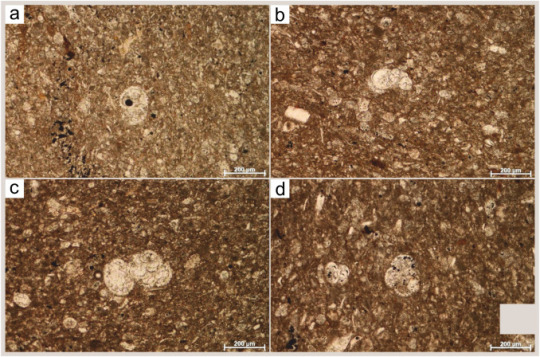
a bivalve called Crassatella,
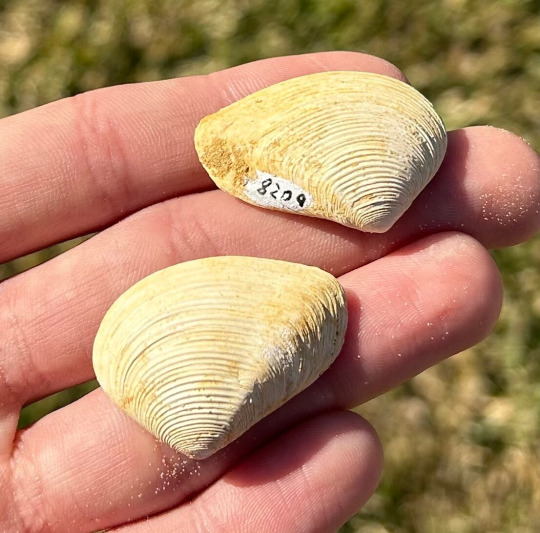
other snails,
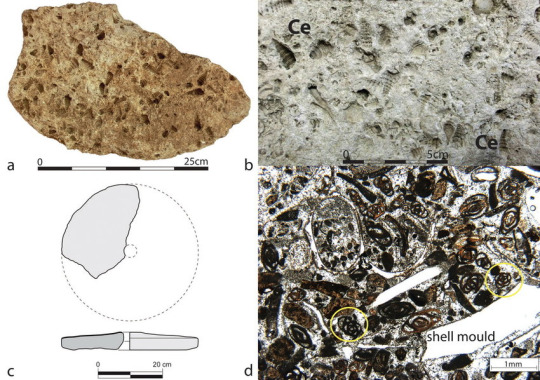
and marine worms.
C. giganteum is actually only one species of many within the genus Campanile. it belongs in the phylum Mollusca which includes snails, cephalopods and bivalves.
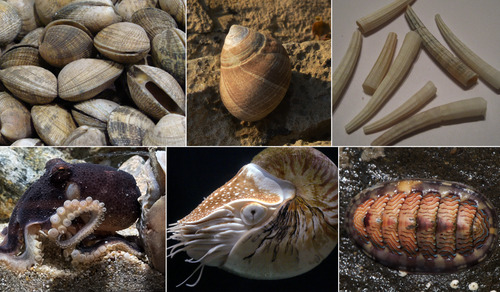
From there they belong in the class gastropoda, commonly known as snails and slugs.

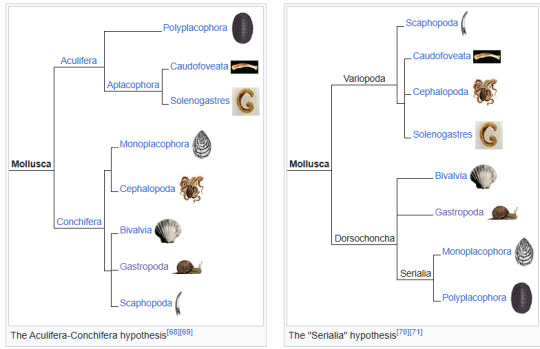
There's currently a bit of debate going on with taxonomy further down, but there are at least 18 named species of Campanile including one living species C. symbolicum whose common name is the Bell Clapper or Giant Creeper. It lives in coastal waters off southwestern Australia.
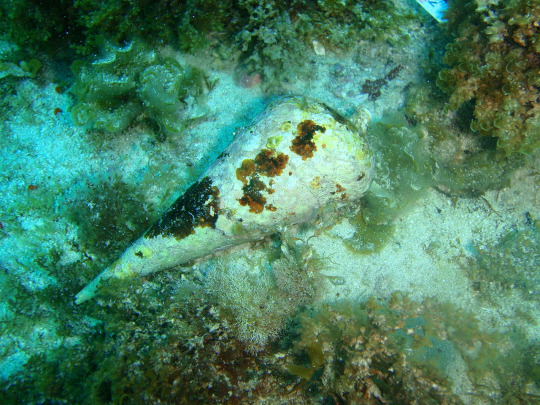
C. giganteum was the largest gastropod to have lived (as far as we know). It got up to 35 in (90cm) on average. C. symbolicum only gets to a little less than 10 inches (24 cm).
A study was done in 2020 on C. giganteum in regard to growth and paleoseasonality. They found that C. giganteum grew upwards of 600 mm per year along the helix of their shell. They concluded that it lived in water between 21-32 degrees Celsius (69.8-89.6 degrees F) which really isn't all that different from the Mediterranean Sea today (a little warmer). If you want to read more about this study, here's the link:
https://agupubs.onlinelibrary.wiley.com/doi/full/10.1029/2019GC008794
Make sure you tune in Monday as we talk more about different types of igneous rocks! Fossilize you later!

26 notes
·
View notes
Text
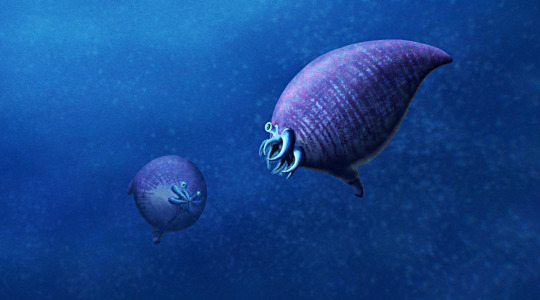
Hexameroceras panderi was a nautiloid cephalopod that lived during the late Silurian, about 425-423 million years ago, in what is now Czechia.
Around 5cm long (2"), it had a downwards-curving egg-shaped shell that preserved the original color pattern on one fossil specimen, showing closely-packed crisscrossing vertical and horizontal bands.
Like several of its close oncocerid and discosorid relatives, its shell also developed a highly constricted opening as it reached maturity. This eventually formed into a narrow visor-like shape with several lobes that probably correlated to the life positions of the eyes and arms, with a "spout" at the bottom for the siphon.
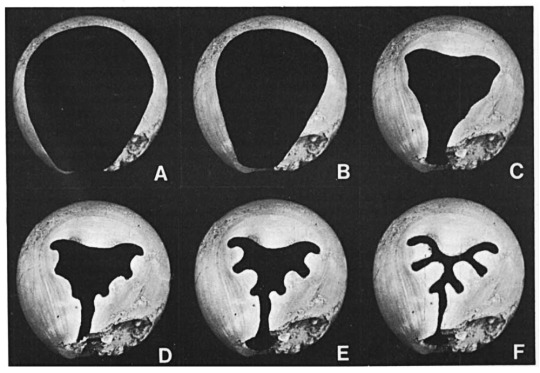
Development of the "visor" in the related Octameroceras sinuosum From fig 6 in Stridsberg (1981)
The function of this structure is still unclear. It may have been a defensive measure against predators – but it would have also severely limited the range of motion of the arms and the size of food that could be eaten through the mouth, suggesting that Hexameroceras may have specialized in very small prey, perhaps even filter-feeding.
Another possibility is that these visored nautiloids might represent brooding females, walling themselves into their shells to protect their eggs and dying after releasing the hatchlings through the tiny remaining gap.
———
NixIllustration.com | Tumblr | Patreon
References:
"Hexameroceras." Paleobiology Database, https://paleobiodb.org/classic/checkTaxonInfo?taxon_no=13035
Mironenko, Aleksandr A. "Early Palaeozoic Discinocarina: a key to the appearance of cephalopod jaws." Lethaia 54.4 (2021): 457-476. https://doi.org/10.1111/let.12414
Mutvei, Harry. "Siphuncular structure in Silurian discosorid and ascocerid nautiloids (Cephalopoda) from Gotland, Sweden: implications for interpretation of mode of life and phylogeny." Gff 134.1 (2012): 27-37. https://doi.org/10.1080/11035897.2012.654507
Stridsberg, Sven. "Apertural constrictions in some oncocerid cephalopods." Lethaia 14.4 (1981): 269-276. https://doi.org/10.1111/j.1502-3931.1981.tb01098.x
Turek, Vojtech, and Š. Manda. "Colour pattern polymorphism in Silurian nautiloid Phragmoceras Broderip, 1839." Bulletin of Geosciences 86.1 (2011): 91-105. http://dx.doi.org/10.3140/bull.geosci.1240
Wikipedia contributors. “Hexameroceras.” Wikipedia, 29 Jun. 2022, https://en.wikipedia.org/wiki/Hexameroceras
#science illustration#paleontology#paleoart#palaeoblr#hexameroceras#hemiphragmoceratidae#oncocerida#nautiloid#cephalopod#mollusc#invertebrate#art
330 notes
·
View notes
Text
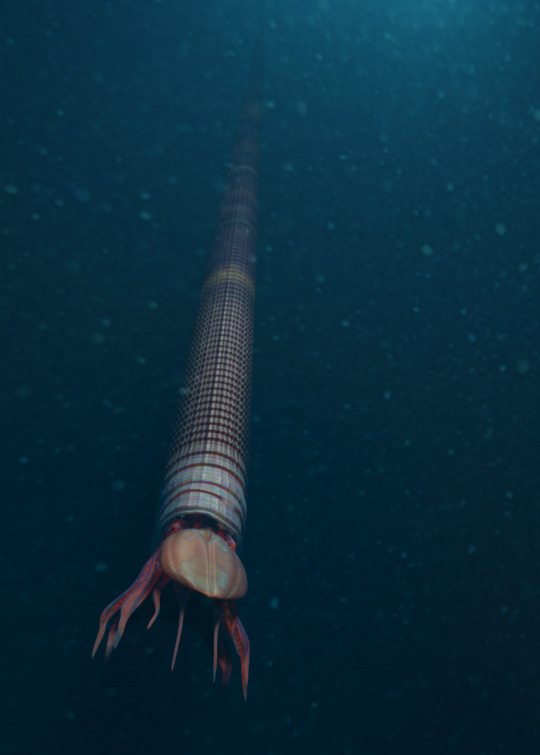
Dawsonoceras is another cephalopod that swam the waters of Sillurian Gotland. They are an orthoceratid straight-shelled nautilid that floated in a vertical position on the water collumn.
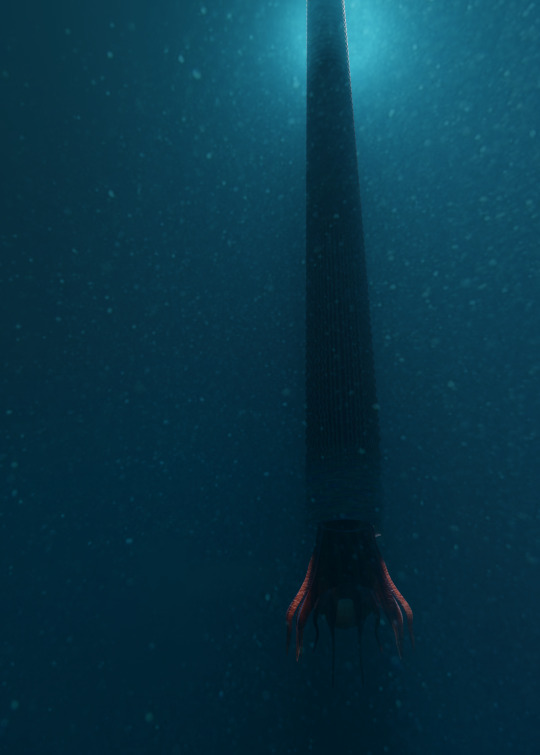
Although they are far smaller than some of the other orthocones and endoceratids that reached lengths of up to 5 meters, their shell is just as beautiful to behold.
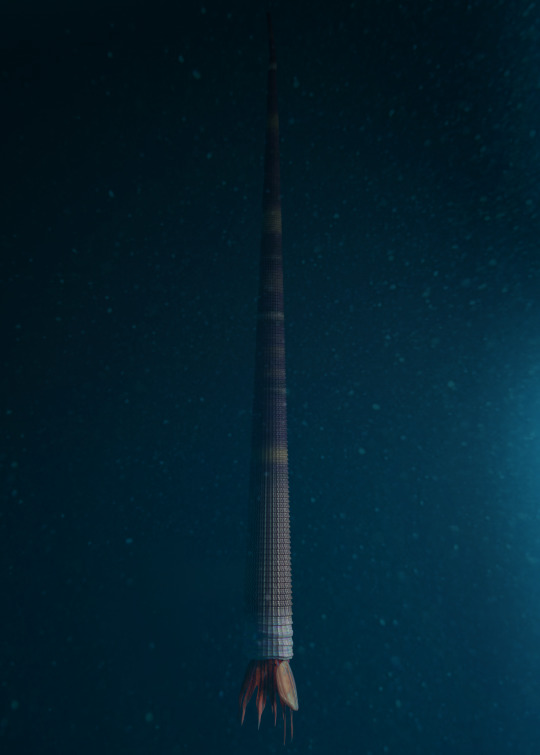
Kröger, B. (2013). The cephalopods of the Boda Limestone, Late Ordovician, of Dalarna, Sweden. European Journal of Taxonomy, (41).
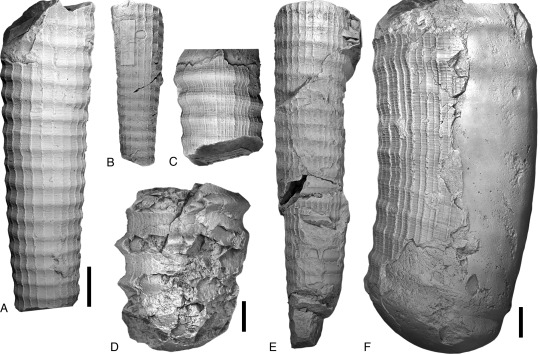
Above specimens A,B, & E are dawsonoceratids, Scale bars: 10 mm.
From what I can gather, their adult shell diameter reaches 2.5 cm wide and it's hard to guess the total length because a lot of the shells are fragmentary. There seems to be one complete specimen online that was described to be 7.1" inches long
And another here that's 40 cm long, although it's an ID-guess from the blog poster
#paleoart#palaeoblr#paleontology#cephalopod#blender#blender3d#3d model#3d art#3d modelling#3d#orthocone#dawsonoceras#silurian#gotland
616 notes
·
View notes
Text
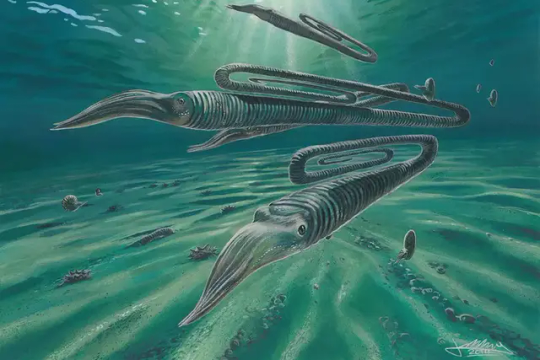
Convergent evolution is the evolution of 'analogous' or similar structures in organisms that are not closely related. Such as the wings of insects, birds and bats. One potential example of this is the Diplomoceras maximum, an extinct squid-like creature who is clearly analogous to, or a distant cousin of Clippy the paperclip. This amazing creature lived 68 million years ago, with the most notable fossil found at the cephalopod rich López de Bertodano Formation of Seymour Island, Antarctica. An area that was formerly warmer before further movement of tectonic plates. The fossil shell measured an impressive 1.5 metres and is formed from ridges, speculated to grow a section annually. These ribs are thought be similar to tree rings, being used for dating samples and gaining insight about the environment of the prehistoric sea, such as measuring the carbon and oxygen isotopes in the shell. Paleoart by James McKay
#marine biology#marine life#marine animals#ocean animals#marine zoology#cephalopods#molluscs#paleontology#fossils#ocean#wet beast wednesday#marine ecosystem#marine#zoology#animal facts#animalia#animal#sea animals#sea creature#sea creatures#sea life#ocean life
205 notes
·
View notes
Text
Amphibian Perucetus and giant scissor sharks
In previous posts, we considered Moropiton and Poseideongenia, two groups of animals that migrated to Siberia through the Ural Sea in the Late Carboniferous. Before moving on to the actual descendants of these Seymouries - the Angarians themselves - we can distract ourselves with the creatures that the Moscow settlers could encounter on a vegetable raft.

The Dynasty of marine amphibians
Let's start with a strange speculative kind that shouldn't exist. Ichthyocetus, the "whale fish", is a large animal reaching a size of up to 2.5 meters and is a direct descendant of tetrapods of the Moscow Sea, primarily tulerpeton. The latter is known primarily for its six-toed limbs developed relative to other modern tetropods, as well as for its location. The fact is that the remains of the tulerpiton were located 200 kilometers from the supposed shore: this and the very structure of the body of the tetrapod under discussion suggest that the animal lived in shallow water, breathing atmospheric air (no bones corresponding to the gills were found, and the head was separated from the body - i.e. the tulerpeton could lift its head) and moving forward using the legs, pushing them off the bottom (their strength would not be enough to allow the toolerpeton to move on land). It is possible that some tetrapods could have stayed in this habitat, becoming the main predators of shallow waters, where larger predators like eugeneodonts or placoderms could not move normally.

Tulerpeton, 360 m.y.a. Art by Dmitry Bogdanov

Tulerpeton found fossils
Ichthyocetus is the last representative of this hypothetical clade, whose population was almost completely destroyed by the decline in sea level due to the new peak of the Karoo ice Age. His basic diet is benthos, which he can find in the buried ground: echinoderms, starfish and lilies, as well as, if luck smiles, the corpses of marine animals that the surf brings. He could also purposefully hunt for moropitons if they swam too deep. The bones of ichthyocetus are incredibly dense; this allows it to stay in the water during strong waves. This animal is able to sense the approach of a storm - then it tries to find the shore and crawl out onto it, burrowing into the sand; then they are most vulnerable. If it is impossible to find the shore, then the ichthyocetuses go to depth, swallowing air, where they can stay for 3-4 hours. Sometimes this tetropods go deep in search of new food sources, where they can catch young eugeneodonts or small fish. Surprisingly, ichthyocetuses are not the largest representatives of their clade (let's call it Ichthyocetusae): some species could grow up to 3 meters and lead a more pelagic lifestyle.
They usually appeared during periods of intense glaciation with a reduction in their original habitat. Unfortunately, this time climate change has become insurmountable.
Something about scissor sharks
If the meeting of protoseimurians with their "cousin" was unreliable, then the same cannot be said about eugeneodonts. The largest animals of the sea were the edestus, or protopirates. Although the largest protopirate species, E. vorax, could reach 6 meters (making it the largest predator of its time), the Moscow species were somewhat smaller and reached a maximum of 4 meters. These sizes correspond to the modern white shark and mako shark.

Edestus, 313—307 m.y.a. Art by Dmitry Bogdanov

Comparison of the four species of Edestus. Authors of this illustration is Leif Tapanila and Jesse Pruitt
Both poseideonogenes and moropitons encountered these cartilaginous fish - most likely, they were four-meter E. heinrichi and E. triserratus commensurate with ichthyocetus. Most likely, the edestus hunted numerous nautiloids and other soft-bodied prey and could well attack rafts, mistaking them for a dead cephalopod with a spiral shell. The protoseimuria themselves would not be of interest to the edestus - they are too small. That's what saved them.
#original species#spec evo#spec bio#speculative biology#speculative zoology#artists on tumblr#paleoart#art#paleontology#paleozoic
54 notes
·
View notes